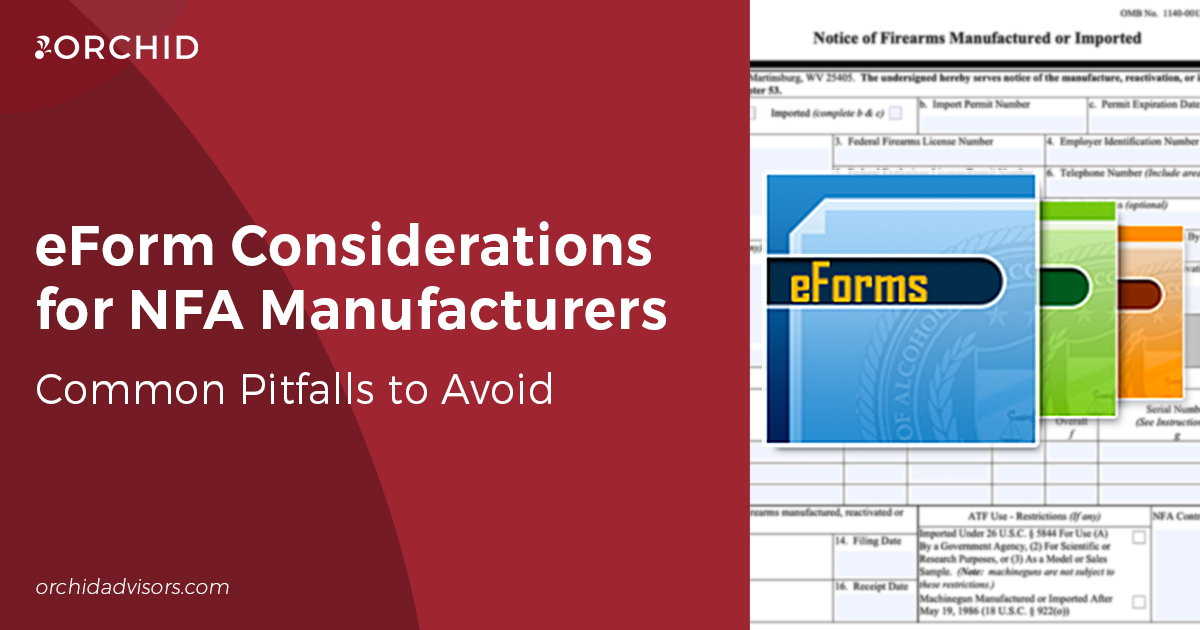Originally enacted in 1934, the National Firearms Act (NFA) imposed a tax on the making and transfer of specific firearms, such as machine guns, silencers and short-barreled rifles and shotguns, as well as a special occupational tax (SOT) on persons and entities manufacturing, importing and dealing NFA firearms.
In addition, engaging in such business requires filing specific ATF forms with NFA Division offices. Available as paper applications, these forms can also be completed and filed electronically through the ATF eForms system, designed to improve accuracy and efficiency for both FFLs and the ATF.
Whether you’re already engaged in the manufacturing of NFA firearms or interested in becoming a Type 07 or 10 FFL, we’ve laid out various considerations when using NFA eForms – beginning with the forms you’ll need to use.
NFA Forms
As an NFA firearms manufacturer, you need to be aware of six ATF forms: Form 1, 2, 3, 4, 5 and 9. Depending on the nature of your business, you may or may not use all related forms.
To use ATF eForms, you must first register online at eforms.atf.gov. Once registered and your account associated with your FFL, all forms can be filed electronically – except for Form 4, which is currently not in service but is expected to be reimplemented this fall. Descriptions and typical use for each form are listed below:
ATF Form 1 – Application to Make and Register a Firearm; filed by an individual or entity to get approval to make and register an NFA firearm
ATF Form 2 – Notice of Firearms Manufactured or Imported; filed by a qualified manufacturer or importer to register NFA firearms manufactured or imported
ATF Form 3 – Application for Tax-Exempt Transfer of Firearms and Registration to SOT; filed by a qualified FFL to transfer to another qualified FFL
ATF Form 4 – Application for Tax Paid Transfer and Registration of Firearm; filed by an individual or entity to request approval to transfer a NFA firearm subject to transfer tax liability
ATF Form 5 – Application for Tax-Exempt Transfer of Firearms and Registration of Firearm; filed by a current registrant when firearm is being transferred to or from a government entity
ATF Form 9 – Application and Permit for Permanent Exportation of Firearms; filed by a qualified FFL for the exportation of NFA firearms
NFA eForm Considerations
Now that you know the eForms you’ll need to file to make, transfer and export NFA firearms as a manufacturer, it’s important to know common pitfalls to avoid when using them.
Application Accuracy
When completing any federal document, accuracy is paramount. This is especially true with ATF eForms, as applications cannot be updated or edited once submitted. If an error is made, the application may be disapproved and a new form submitted with the correct information. If tax was paid for the disapproved form, it may be refunded, and if so, a new tax payment must be made.
ATF eForms significantly reduce errors common to paper applications, but mistakes are inevitable. When filing an eForm, the following fields should always be reviewed for accuracy:
- Applicant License number and expiration date
- Applicant name, address and contact information
- Product type, model, caliber, dimensions and serial number
If bulk uploading NFA firearms using an external document, the accuracy of every field for every product should be ensured prior to uploading and submitting the eForm.
Timely Filing
In addition to knowing how to fill out NFA eForms, manufacturers must also understand the process of when to file each form. For instance, all NFA firearms manufactured on a single day must be included on one Form 2 and filed no later than the close of the next business day. All forms must also be approved by the ATF prior to the transfer or export of included NFA firearms. Failing to file or wait for approval are major FFL violations you absolutely want to avoid.
Application Delays
While there is no requirement for manufacturers to seek an ATF classification for new products, doing so in advance of manufacture is good business practice. As such, informing the ATF of a new NFA firearm model, or even an existing NFA firearm in a new caliber, prior to submitting an eForm is recommended so the ATF may add the firearm to their system and avoid delays in processing.
The ATF tracks and shares the average processing time of forms filled out correctly and completely. As of this writing, Forms 2, 3, 5 and 9 are averaging 10 days, whereas Form 1 applications are averaging 60 days. This is one of the greatest benefits of the ATF eForm system, as paper applications for the same forms are averaging 30–120 days.
Proper Recordkeeping
As with GCA firearms, manufacturers must also maintain permanent records of NFA firearms. These records, required to be kept in paper, can also be stored on a computer hard drive or digitally in the cloud with an authorized ATF variance. Orchid was the first to obtain such a variance and has led the way for others to do the same. However, these alternative storage variances are not without their own requirements, such as daily backups and periodic printouts, for manufacturers to adhere to for proper compliance.
Once an eForm is submitted, applications should be confirmed with the ATF for accuracy against internal records and any discrepancies reconciled.
ATF eForms have made filing forms for NFA firearms easier for all parties involved, but they’re not without their compliance risks. For questions regarding NFA firearms and regulations, ATF eForms or how to get your FFL/SOT, contact us today to learn how Orchid FFL services and training can help you.







0 Comments